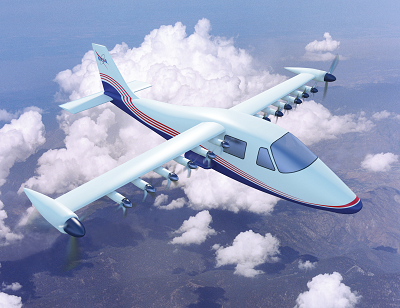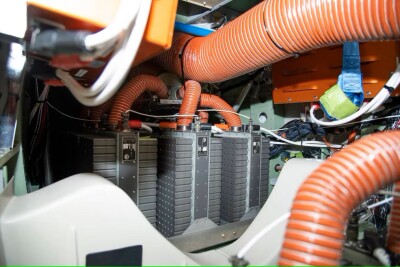On June 23 the National Aeronautics and Space Administration (NASA) announced that it was cancelling the X-57 project with a simple press release and little fanfare.
What happened to the electric aircraft that promised to give us zero emissions flights? The reasons on the NASA website are somewhat vague.
 According to the federal agency press release: “The project encountered several challenges to safe flight, including mechanical issues late into its lifecycle and a lack of availability of critical components required to develop experimental hardware.”
According to the federal agency press release: “The project encountered several challenges to safe flight, including mechanical issues late into its lifecycle and a lack of availability of critical components required to develop experimental hardware.”
Unfortunately for the Advanced Air Mobility (AAM) industry—a term created by NASA, by the way, to replace the old Urban Air Mobility (UAM)—the cancelation of the program might mean that the federal agency encountered certain roadblocks that, given current battery technology, are impossible to overcome.
For years, some aerospace scientists and engineers have been saying that purely electric vertical takeoff and landing (eVTOL) aircraft are not feasible given current battery technology.
Mark Moore, CEO of Whisper Aero, has been very vocal about the dubious viability of certain popular AAM designs that have managed to raise millions of dollars in the stock market. The feasibility of these designs, not only in terms of safely flying from point A to point B, but their capacity to scale and become a regular service using only batteries has been called into question by the aerospace expert.
Joshua Resnick, CEO of Parallel Flight Technology, who left Tesla to start his uncrewed aviation company, was somewhat more reserved about the negative implications of the NASA announcement for the AAM industry.
"I don’t believe the cancellation of the X-57 project by NASA means that the advanced air mobility industry is in trouble. NASA was trying to modify a conventional aircraft with an electric powertrain to specifically show the efficiency increases of distributing electric propulsion, which it sounds like they made significant progress on. This was an experimental testbed, not a product.  That’s very different from the approach the industry is taking, which always involves engineering advanced airframes from the ground up around the requirements of the electric propulsion components. This is especially true for an eVTOL vehicle. Companies such as Joby have proven beautifully that battery eVTOLs can deliver on performance—but that required huge investments and building everything from scratch. For pure vertical lift systems where long duration and heavy payload are required, such as the ones we are building at Parallel Flight Technologies, we believe gas-electric hybrid systems make sense. However, for AAM applications, where acoustics and carbon footprint are key, pure battery or battery-hydrogen systems will be the solution."
That’s very different from the approach the industry is taking, which always involves engineering advanced airframes from the ground up around the requirements of the electric propulsion components. This is especially true for an eVTOL vehicle. Companies such as Joby have proven beautifully that battery eVTOLs can deliver on performance—but that required huge investments and building everything from scratch. For pure vertical lift systems where long duration and heavy payload are required, such as the ones we are building at Parallel Flight Technologies, we believe gas-electric hybrid systems make sense. However, for AAM applications, where acoustics and carbon footprint are key, pure battery or battery-hydrogen systems will be the solution."
By carefully reviewing the project specifications of the X-57 project, we can deduce that what NASA was trying to demonstrate is different from what the AAM industry is trying to achieve. One issue that both initiatives have in common is that some companies like Archer and Joby are insisting on using only current battery technology and that is one area that NASA identified as problematic. According to the press release: “The lithium-ion batteries installed on the aircraft warm up as they discharge energy and too much warming could result in overheating.”
This is something that everyone seems to be focused on and concerned about. Aircraft have to fight gravity all the time, and their batteries have to be discharging high amounts of energy constantly. This is one of the big differences with electric cars, in which the battery system is not required to keep an object from falling from the sky. The demands for power on a ground vehicle and an aircraft are radically different and the AAM industry has been struggling with this reality from the beginning.
NASA was also facing cost overruns, and it was rumored that they needed an additional $47 million on top of the original $40 million just to keep going. The foundation for the X-57 program was the assumption that existing electric propulsion systems were technologically advanced, but this proved to be incorrect as several subsystems were not viable to ensure safe flight operations.
But there are alternatives to current eVTOL designs and our favorite is Electra Aero, where John S. Langford and his brilliant team of engineers are approaching the entire problem from a different angle: electric short take off and landings (eSTOL). According to the company, “compared to vertical lift designs, electric short takeoff and landing (eSTOL) delivers more than twice the payload and ten times the range at substantially lower operating costs—making it the ideal choice for middle-mile passenger mobility and cargo logistics.”
The big difference between eVTOL and eSTOL is that the latter uses parts of the wing to create lift in combination with the powerful thrust from the engines, in other words, the engines “are not alone” in the landing and takeoff phases of flight. A brilliant idea that is now entering the test stage as Electra.aero “is getting the technology demonstrator ready to fly.”
In any case, we started this article with a clear implication that the cancellation of NASA’s X-57 project was a devastating blow to the AAM industry and anecdotal data and conversations with industry leaders prove us wrong, something for which we are eternally grateful. This industry seems to be going full steam ahead as different designs and disparate approaches race to the finish line in search of something viable and scalable.





.jpg.small.400x400.jpg)









Comments